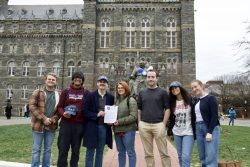D.C.’s new mayor, Muriel Bowser, campaigned on a platform that promised to end homelessness in D.C. by 2025. A report released last month by the D.C. Fiscal Policy Institute, however, highlights the fact that the District still desperately needs better infrastructure for the homeless population. If Bowser truly intends to reach her goal, she needs to be more proactive in developing a practical and comprehensive plan to accomplish her promise.
The “Report Card on D.C.’s Progress in Helping Homeless Families” graded the government based on how well it fulfilled ten roadmap goals for a “high quality homeless services system.” The District had a mediocre performance, receiving one B, seven C’s, and two D’s.
The grades, which evaluate the administration of former mayor Vincent Gray, can give Bowser and her team concrete goals and suggestions. If she takes the criticism seriously, she can make huge improvements on these scores. In her campaign pledges, Bowser was right to criticize the homelessness policies of Gray’s administration. But her one and a half page blueprint to end homelessness in D.C. in ten years feels like a half-hearted effort.
Bowser’s plan outlines short and long term strategies for eradicating homelessness. Bowser vows to not house the homeless in recreation centers—a violation of the Homeless Services Reform Act—and instead pushes for expansion of Rapid Re-housing and the Local Rent Supplement Program.
Unfortunately, this plan alone isn’t going to do anything in the short term. With temperatures staying below freezing this calendar year, the decaying D.C. General shelter and multiple motels leased by the District for the winter have been filled to capacity. Some homeless individuals are finding themselves in the recreation centers Bowser has promised to stop using. The numbers of homeless requiring the government’s attention won’t be decreasing anytime soon.
Rapid Re-housing operates on the assumption that once-homeless individuals will be able to pay Washington-level rents in four months to a year. Yet, as the report highlights, “the District has not explored ways for families to easily re-engage if they fall into trouble after leaving Rapid Re-housing.” In a tight economy where prices are skyrocketing and precincts are gentrifying thanks to the influx of young professionals, those who cannot make do without the program’s time-limited subsidy can soon become homeless once again.
The report card also pushes D.C. to think more critically about how it finds funds for projects. It acknowledged that the government found funding to safely house families in private shelters during winters. However, the money came from an existing federal aid program called Temporary Assistance for Needy Families. The District must do more for its citizens than to simply take funds from a pre-existing welfare program.
As D.C. continues to endure a particularly cold and snowy winter, Bowser’s newly minted administration needs to reevaluate the government’s homelessness record and make a vested effort to come up with a practical plan of action. District residents should be keeping a keen eye on what Bowser and her team do first.




